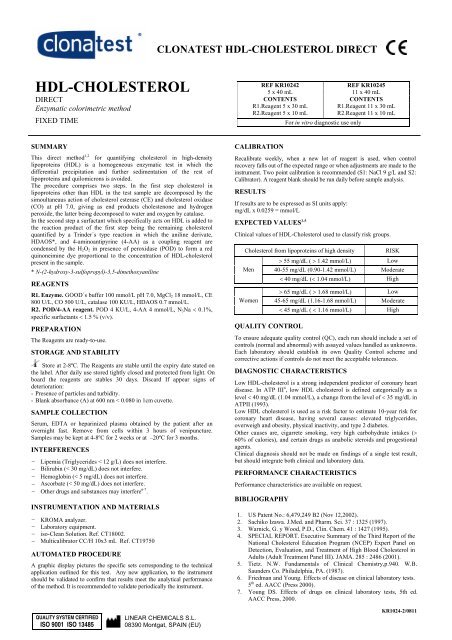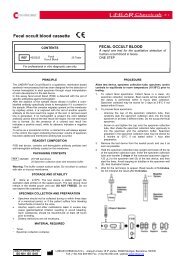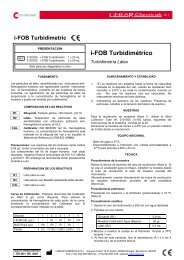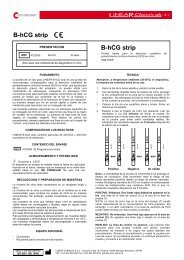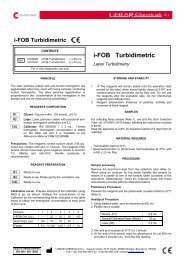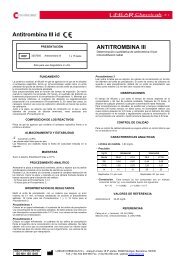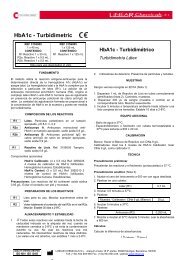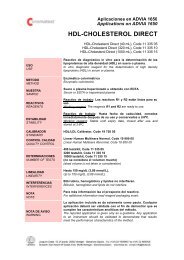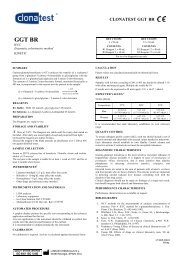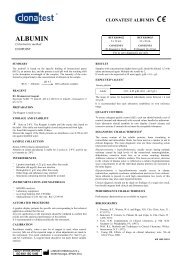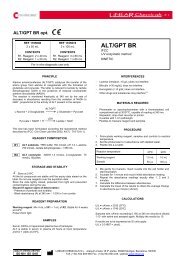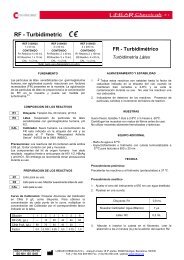hdl-cholesterol direct - Linear
hdl-cholesterol direct - Linear
hdl-cholesterol direct - Linear
Create successful ePaper yourself
Turn your PDF publications into a flip-book with our unique Google optimized e-Paper software.
CLONATEST HDL-CHOLESTEROL DIRECT<br />
HDL-CHOLESTEROL<br />
DIRECT<br />
Enzymatic colorimetric method<br />
FIXED TIME<br />
REF KR10242<br />
REF KR10245<br />
5 x 40 mL 11 x 40 mL<br />
CONTENTS<br />
CONTENTS<br />
R1.Reagent 5 x 30 mL R1.Reagent 11 x 30 mL<br />
R2.Reagent 5 x 10 mL R2.Reagent 11 x 10 mL<br />
For in vitro diagnostic use only<br />
SUMMARY<br />
This <strong>direct</strong> method 1,2 for quantifying <strong>cholesterol</strong> in high-density<br />
lipoproteins (HDL) is a homogeneous enzymatic test in which the<br />
differential precipitation and further sedimentation of the rest of<br />
lipoproteins and quilomicrons is avoided.<br />
The procedure comprises two steps. In the first step <strong>cholesterol</strong> in<br />
lipoproteins other than HDL in the test sample are decomposed by the<br />
simoultaneaus action of <strong>cholesterol</strong> esterase (CE) and <strong>cholesterol</strong> oxidase<br />
(CO) at pH 7.0, giving as end products cholestenone and hydrogen<br />
peroxide, the latter being decomposed to water and oxygen by catalase.<br />
In the second step a surfactant which specifically acts on HDL is added to<br />
the reaction product of the first step being the remaining <strong>cholesterol</strong><br />
quantified by a Trinder´s type reaction in which the aniline derivate,<br />
HDAOS*, and 4-aminoantipyrine (4-AA) as a coupling reagent are<br />
condensed by the H 2 O 2 in presence of peroxidase (POD) to form a red<br />
quinoneimine dye proportional to the concentration of HDL-<strong>cholesterol</strong><br />
present in the sample.<br />
* N-(2-hydroxy-3-sulfopropyl)-3,5-dimethoxyaniline<br />
REAGENTS<br />
R1. Enzyme. GOOD´s buffer 100 mmol/L pH 7.0, MgCl 2 18 mmol/L, CE<br />
800 U/L, CO 500 U/L, catalase 100 KU/L, HDAOS 0.7 mmol/L.<br />
R2. POD/4-AA reagent. POD 4 KU/L, 4-AA 4 mmol/L, N 3 Na < 0.1%,<br />
specific surfactants < 1.5 % (v/v).<br />
PREPARATION<br />
The Reagents are ready-to-use.<br />
STORAGE AND STABILITY<br />
Store at 2-8ºC. The Reagents are stable until the expiry date stated on<br />
the label. After daily use stored tightly closed and protected from light. On<br />
board the reagents are stables 30 days. Discard If appear signs of<br />
deterioration:<br />
- Presence of particles and turbidity.<br />
- Blank absorbance (A) at 600 nm < 0.080 in 1cm cuvette.<br />
SAMPLE COLLECTION<br />
Serum, EDTA or heparinized plasma obtained by the patient after an<br />
overnight fast. Remove from cells within 3 hours of venipuncture.<br />
Samples may be kept at 4-8ºC for 2 weeks or at –20ºC for 3 months.<br />
INTERFERENCES<br />
−<br />
−<br />
−<br />
−<br />
−<br />
Lipemia (Triglycerides < 12 g/L) does not interfere.<br />
Bilirubin (< 30 mg/dL) does not interfere.<br />
Hemoglobin (< 5 mg/dL) does not interfere.<br />
Ascorbate (< 50 mg/dL) does not interfere.<br />
Other drugs and substances may interfere 6-7 .<br />
INSTRUMENTATION AND MATERIALS<br />
−<br />
−<br />
−<br />
−<br />
KROMA analyzer.<br />
Laboratory equipment.<br />
iso-Clean Solution. Ref. CT18002.<br />
Multicalibrator CC/H 10x3 mL Ref. CT19750<br />
AUTOMATED PROCEDURE<br />
A graphic display pictures the specific sets corresponding to the technical<br />
application outlined for this test. Any new application, to the instrument<br />
should be validated to confirm that results meet the analytical performance<br />
of the method. It is recommended to validate periodically the instrument.<br />
CALIBRATION<br />
Recalibrate weekly, when a new lot of reagent is used, when control<br />
recovery falls out of the expected range or when adjustments are made to the<br />
instrument. Two point calibration is recommended (S1: NaCl 9 g/L and S2:<br />
Calibrator). A reagent blank should be run daily before sample analysis.<br />
RESULTS<br />
If results are to be expressed as SI units apply:<br />
mg/dL x 0.0259 = mmol/L<br />
EXPECTED VALUES 3-5<br />
Clinical values of HDL-Cholesterol used to classify risk groups.<br />
Cholesterol from lipoproteins of high density<br />
RISK<br />
> 55 mg/dL ( > 1.42 mmol/L) Low<br />
Men 40-55 mg/dL (0.90-1.42 mmol/L) Moderate<br />
< 40 mg/dL (< 1.04 mmol/L) High<br />
Women<br />
QUALITY CONTROL<br />
> 65 mg/dL ( > 1.68 mmol/L) Low<br />
45-65 mg/dL (1.16-1.68 mmol/L) Moderate<br />
< 45 mg/dL ( < 1.16 mmol/L) High<br />
To ensure adequate quality control (QC), each run should include a set of<br />
controls (normal and abnormal) with assayed values handled as unknowns.<br />
Each laboratory should establish its own Quality Control scheme and<br />
corrective actions if controls do not meet the acceptable tolerances.<br />
DIAGNOSTIC CHARACTERISTICS<br />
Low HDL-<strong>cholesterol</strong> is a strong independent predictor of coronary heart<br />
disease. In ATP III 4 , low HDL <strong>cholesterol</strong> is defined categorically as a<br />
level < 40 mg/dL (1.04 mmol/L), a change from the level of < 35 mg/dL in<br />
ATPII (1993).<br />
Low HDL <strong>cholesterol</strong> is used as a risk factor to estimate 10-year risk for<br />
coronary heart disease, having several causes: elevated triglycerides,<br />
overweigh and obesity, physical inactivity, and type 2 diabetes.<br />
Other causes are, cigarrete smoking, very high carbohydrate intakes (><br />
60% of calories), and certain drugs as anabolic steroids and progestional<br />
agents.<br />
Clinical diagnosis should not be made on findings of a single test result,<br />
but should integrate both clinical and laboratory data.<br />
PERFORMANCE CHARACTERISTICS<br />
Performance characteristics are available on request.<br />
BIBLIOGRAPHY<br />
1.<br />
2.<br />
3.<br />
4.<br />
5.<br />
6.<br />
7.<br />
US Patent No.: 6,479,249 B2 (Nov 12,2002).<br />
Sachiko Izawa. J.Med. and Pharm. Sci. 37 : 1325 (1997).<br />
Warnick, G. y Wood, P.D., Clin. Chem. 41 : 1427 (1995).<br />
SPECIAL REPORT. Executive Summary of the Third Report of the<br />
National Cholesterol Education Program (NCEP) Expert Panel on<br />
Detection, Evaluation, and Treatment of High Blood Cholesterol in<br />
Adults (Adult Treatment Panel III). JAMA. 285 : 2486 (2001).<br />
Tietz. N.W. Fundamentals of Clinical Chemistry,p.940. W.B.<br />
Saunders Co. Philadelphia, PA. (1987).<br />
Friedman and Young. Effects of disease on clinical laboratory tests.<br />
5 th ed. AACC (Press 2000).<br />
Young DS. Effects of drugs on clinical laboratory tests, 5th ed.<br />
AACC Press, 2000.<br />
QUALITY SYSTEM CERTIFIED<br />
ISO 9001 ISO 13485<br />
LINEAR CHEMICALS S.L.<br />
08390 Montgat, SPAIN (EU)<br />
KR1024-2/0811
CLONATEST HDL-CHOLESTEROL DIRECT<br />
COLESTEROL-HDL<br />
DIRECTO<br />
Método enzimático colorimétrico<br />
PUNTO FIJO<br />
REF KR10242<br />
REF KR10245<br />
5 x 40 mL 11 x 40 mL<br />
CONTENIDO<br />
CONTENIDO<br />
R1.Reactivo 5 x 30 mL R1.Reactivo 11 x 40 mL<br />
R2.Reactivo 5 x 10 mL R2.Reactivo 11 x 10 mL<br />
Sólo para uso diagnóstico in vitro<br />
FUNDAMENTO<br />
Este método <strong>direct</strong>o 1,2 para cuantificar el colesterol en las lipoproteinas de alta<br />
densidad (HDL) es una prueba enzimática homogénea en la que la<br />
precipitación diferencial y la posterior sedimentación del resto de lipoproteinas<br />
y quilomicrones ha sido eliminada.<br />
El procedimiento consta de dos etapas. En la primera el colesterol de las<br />
lipoproteinas distintas a las HDL presentes en la muestra se descomponen por<br />
la acción simultánea de la colesterol esterasa (CE) y la colesterol oxidasa (CO)<br />
a pH 7,0, dando como productos finales colestenona y peróxido de hidrógeno<br />
convirtiéndose éste último en oxígeno y agua por la acción de la catalasa. En<br />
una segunda etapa, un tensioactivo que actúa específicamente sobre la HDL se<br />
añade al producto del paso anterior, cuantificándose el colesterol residual<br />
mediante una reacción tipo Trinder en la que el derivado anilínico, HDAOS*,<br />
y la 4-aminoantipirina (4-AA) se condensan por el H 2 O 2 en presencia de<br />
peroxidasa (POD) para formar una quinonaimina roja proporcional a la<br />
concentración de colesterol-HDL presente en la muestra.<br />
* N-(2-hidroxi-3-sulfopropil)-3,5-dimetoxianilina<br />
REACTIVOS<br />
R1. Reactivo enzimático. Tampón GOOD 100 mmol/L pH 7,0, MgCl 2 18<br />
mmol/L, CE 800 U/L, CO 500 U/L, catalasa 100 KU/L, HDAOS 0,7 mmol/L.<br />
R2. Reactivo POD/4-AA. POD 4 KU/L, 4-AA 4 mmol/L, N 3 Na < 0.1%,<br />
tensioactivos específicos < 1.5 % (v/v).<br />
PREPARACION<br />
Los reactivos R1 y R2 están listos para su uso.<br />
ALMACENAMIENTO Y ESTABILIDAD<br />
Conservar a 2-8ºC. Los Reactivos son estables hasta la fecha de<br />
caducidad indicada en la etiqueta. Después de su uso diario, mantenerlos<br />
bien cerrado y protegido de la luz. En el analizador son estables 30 días.<br />
Descartar si se observan signos de deterioro:<br />
- Presencia de partículas y turbidez.<br />
- Absorbancia del Blanco (A) a 600 nm < 0,080 en cubeta de 1 cm.<br />
MUESTRAS<br />
Suero o plasma heparinizado u obtenido con EDTA. El paciente estará en<br />
ayunas desde la noche anterior a la extracción. Separar las células dentro<br />
de las 3 horas siguientes a la venipuntura. Las muestras pueden conservarse<br />
2 semanas a 4-8ºC ó 3 meses a –20ºC.<br />
INTERFERENCIAS 6-7<br />
−<br />
−<br />
−<br />
−<br />
−<br />
Lípidos (Triglicéridos < 12 g/L) no interfiere.<br />
Bilirrubina (< 30 mg/dL) no interfiere.<br />
Hemoglobina (< 5 mg/dL) no interfiere.<br />
Ascorbato (< 50 mg/dL) no interfiere.<br />
Otros medicamentos y sustancias pueden interferir 6-7 .<br />
EQUIPO ADICIONAL<br />
−<br />
−<br />
−<br />
−<br />
Analizador KROMA.<br />
Material de laboratorio.<br />
iso-Clean Solution. Ref. CT18002.<br />
Multicalibrator CC/H 10x3 mL Ref. CT19750<br />
TECNICA AUTOMATICA<br />
Una representación grafica visualiza los ajustes específicos<br />
correspondientes a la aplicación técnica diseñada para este ensayo.<br />
Cualquier aplicación nueva al instrumento deberá validarse para<br />
confirmar que los resultados cumplen las características del método.<br />
Se recomienda validar periódicamente el instrumento.<br />
QUALITY SYSTEM CERTIFIED<br />
ISO 9001 ISO 13485<br />
LINEAR CHEMICALS S.L.<br />
08390 Montgat, SPAIN (EU)<br />
CALIBRACION<br />
Recalibrar semanalmente, al cambiar el lote de reactivos, cuando los<br />
valores del control estén fuera del rango de aceptación o cuando se<br />
realicen ajustes en el instrumento. Se recomienda la Calibración de dos<br />
puntos (M1: ClNa 9 g/L y M2: Calibrador). Realizar un blanco del<br />
reactivo cada día de trabajo antes de analizar las muestras.<br />
CALCULOS<br />
Para expresar los resultados en unidades SI aplicar:<br />
mg/dL x 0,0259 = mmol/L<br />
VALORES DE REFERENCIA 3-5<br />
Valores clínicos de HDL-Colesterol empleados para clasificar grupos de<br />
riesgo.<br />
Colesterol de lipoproteinas de alta densidad RIESGO<br />
> 55 mg/dL ( > 1,42 mmol/L) Bajo<br />
Hombres 40-55 mg/dL (0,90-1,42 mmol/L) Moderado<br />
< 40 mg/dL (< 1,04 mmol/L) Alto<br />
Mujeres<br />
> 65 mg/dL ( > 1,68 mmol/L) Bajo<br />
45-65 mg/dL (1,16-1,68 mmol/L) Moderado<br />
< 45 mg/dL ( < 1,16 mmol/L) Alto<br />
Se recomienda que cada laboratorio establezca su propio rango de<br />
referencia.<br />
CONTROL DE CALIDAD<br />
Para un control de calidad (CC) adecuado, se incluirán en cada serie<br />
controles valorados (normal y abnormal) que se tratarán como muestras<br />
problema. Cada laboratorio debe establecer su propio Control de Calidad y<br />
sus medidas correctoras cuando los controles no cumplan con las<br />
tolerancias exigidas.<br />
SIGNIFICADO CLINICO<br />
Un valor de Colesterol-HDL bajo es un indicador independiente y firme<br />
de enfermedad coronaria. En ATP III 4 , el valor bajo de Colesterol-HDL<br />
quedó categóricamente definido como un nivel < 40 mg/dL (1,04<br />
mmol/L), un cambio en relación al nivel < 35 mg/dL establecido<br />
anteriormente en ATP II (1993).<br />
Un valor bajo de Colesterol-HDL se emplea como un estimador de riesgo<br />
a 10 años, de padecer la enfermedad cardíaca coronaria debiéndose ésta a<br />
diversas causas: triglicéridos elevados, sobrepeso y obesidad, inactividad<br />
física, tabaco, ingestas muy altas de carbohidratos (> 60% de calorias) y<br />
ciertas drogas como los esteroides y anabolizantes. El diagnóstico clínico<br />
no debe realizarse únicamente con los resultados de un único ensayo, sino<br />
que debe considerarse al mismo tiempo los datos clínicos del paciente.<br />
CARACTERISTICAS ANALITICAS<br />
Las características analíticas están disponibles bajo solicitud.<br />
REFERENCIAS<br />
1.<br />
2.<br />
3.<br />
4.<br />
5.<br />
6.<br />
7.<br />
US Patent No.: 6,479,249 B2 (Nov 12,2002).<br />
Sachiko Izawa. J.Med. y Pharm. Sci. 37 : 1325 (1997).<br />
Warnick, G. y Wood, P.D., Clin. Chem. 41 : 1427 (1995).<br />
SPECIAL REPORT. Executive Summary of the Third Report of the<br />
National Cholesterol Education Program (NCEP) Expert Panel on<br />
Detection, Evaluation, and Treatment of High Blood Cholesterol in<br />
Adults (Adult Treatment Panel III). JAMA. 285 : 2486 (2001).<br />
Tietz. N.W. Fundamentals of Clinical Chemistry,p.940. W.B.<br />
Saunders Co. Philadelphia, PA. (1987).<br />
Friedman y Young. Effects of disease on clinical laboratory tests. 5 th<br />
ed. AACC (Press 2000).<br />
Young DS. Effects of drugs on clinical laboratory tests, 5th ed.<br />
AACC Press, 2000.
Aplicaciones en KROMA<br />
Applications on KROMA<br />
HDL-CHOLESTEROL DIRECT<br />
Two reagents method<br />
HDL-Cholesterol Direct (5 x 40 mL), Code KR10242<br />
HDL-Cholesterol Direct (11 x 40 mL), Code KR10245<br />
USO<br />
USE<br />
METODO<br />
METHOD<br />
MUESTRA<br />
SAMPLE<br />
REACTIVOS<br />
REAGENTS<br />
CALIBRADOR<br />
STANDARD<br />
CONTROL CALIDAD<br />
QUALITY CONTROL<br />
DETERMINACIONES<br />
NUMBER OF TESTS<br />
LINEALIDAD<br />
LINEARITY<br />
NOTA<br />
NOTE<br />
NOTA DE AVISO<br />
WARNING<br />
Reactivo de diagnóstico in vitro para la determinación de las<br />
lipoproteínas de alta densidad (HDL) en suero o plasma.<br />
In vitro diagnostic reagent for the determination of high density<br />
lipoproteins (HDL) in serum or plasma.<br />
Enzimático colorimétrico.<br />
Enzymatic colorimetric.<br />
Suero o plasma heparinizado u obtenido con EDTA.<br />
Serum or EDTA or heparinized plasma.<br />
Los reactivos R1 y R2 están listos para su uso.<br />
The reagents R1 and R2 are ready to use.<br />
HDL/LDL Calibrator, Code CT19750<br />
<strong>Linear</strong> Human Multisera Normal CT19800<br />
<strong>Linear</strong> Human Multisera Abnormal CT19850<br />
1000 tests/kit, Code KR10242<br />
2200 tests/kit, Code KR10245<br />
(no se considera el volumen muerto).<br />
(dead volume is not taken in consideration).<br />
Sin post-dilución automática: Hasta 150 mg/dL<br />
Without automatic post-dilution: Up to 150 mg/dL<br />
Para más información lea el prospecto del reactivo.<br />
For additional information read reagent packaging insert.<br />
La aplicación incluida se da solamente como pauta. Cualquier<br />
aplicación deberá ser validad con el fin de demostrar que se<br />
cumplen las características analíticas del método.<br />
The reported application is given only as a guideline. Any application<br />
to an instrument should be validated to demonstrate that results meet<br />
the performance characteristics of the method.<br />
QUALITY SYSTEM CERTIFIED<br />
ISO 9001 ISO 13485<br />
LINEAR CHEMICALS S.L.<br />
08390 Montgat, SPAIN (EU)
KROMA<br />
HDL-CHOLESTEROL DIRECT<br />
Name N. of Standards N. of rep. Units Stability<br />
HDL-Cholesterol Direct 2 1 mg/dL<br />
*<br />
* entered by the user KR10242-45-1/0907<br />
QUALITY SYSTEM CERTIFIED<br />
ISO 9001 ISO 13485<br />
LINEAR CHEMICALS S.L.<br />
08390 Montgat, SPAIN (EU)


